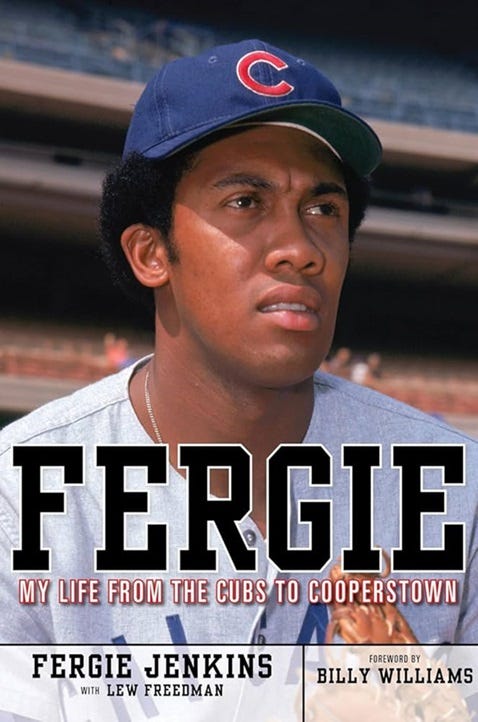Fergie Jenkins, writing with Lew Freedman, penned Fergie: My Life from the Cubs to Cooperstown in 2009. Triumph Books published the memoir. Hall of Fame teammate Billy Williams penned the foreword.
Fergie is one of three books that I’ve recently read again because the original reviews are forever lost to the internet. Anyway, it was worth reading his story again. It was just as quick of a read during Labor Day weekend as it was when I first read the book. Honestly, I had completely forgotten that he pitched for the Texas Rangers when I saw him in a photo honoring Adrian Beltre. Regardless, he had his ups and downs throughout his career. One really feels for him with the tragedies that he went through later in life, losing one wife to a crash and then a daughter to a mentally ill girlfriend.
Unlike so many Black players that played during his era, Fergie did not experience racism growing up in Chatham, Canada. It’s a telling difference between Canada and the United States. His first real experience with racism didn’t come until signing with the Philadelphia Phillies and being sent to Florida.
Fergie played with some of baseball’s greats throughout the years. Upon being traded to the Chicago Cubs early in the 1966 season, he joined a team managed by Leo Durocher and a lineup that included Hall of Famers Ernie Banks, Ron Santo, and Williams. It wouldn’t be until 1967 in which Fergie started developing into a Hall of Fame pitcher, winning 20 games for the first time in his career. It started a streak of six consecutive seasons winning 20 games—a feat that seems impossible in today’s era. Fergie looks back on the 1969 club that came close to playing for the NL pennant, only to see the New York Mets tie them for first in the NL East. The Cubs had held first place for 155 days. But after the Mets tied, they pulled away and won the division.
Back to Fergie’s childhood—he grew up with an interest in multiple sports. Growing up in Canada almost certainly meant having an interest in hockey. He was also into basketball, too. It wasn’t until attending a baseball game between the Detroit Tigers and then-Cleveland Indians that he decided on baseball. He was only 14 years old. Once he took to the mound, baseball would never again be the same.
Fergie suffered a brutal Achilles injury on a routine play during the 1976 season. It could have ended his career on the spot at 33 years old but he rehabbed himself back to the pitching mound. You might say that he wasn’t the best athlete trying to rehab from an injury. He could have just rested after returning to Chatham. Instead, he foolishly decided to check on the animals in his barn during winter when the conditions are treacherous. He fell on the ice and could hardly move. Once he returned to the mound, he turned to narcotics to control the pain in his ankles.
He got into trouble with the law during the 1980 season. It was the type of incident that he believes delayed his induction into the Hall of Fame. After all, he threw over 3,000 strikeouts, which practically guarantees induction for pitchers. Unfortunately, he was 16 wins shy of winning 300 games, another statistical lock for induction. He pitched in a number of games decided by one run or less. Had the offense helped him, it’s possible he would have won 300 before retiring. After first appearing on the ballot for the Class of 1989, Fergie did not break the 75% threshold until 1991, joining Rod Carew and Gaylord Perry. He barely got in with 334 votes (minimum: 333 votes) but he got in. Unfortunately, the aforementioned tragedy struck that year.
After retiring from baseball, Jenkins eventually turned to coaching baseball and working with charities in both the US and Canada. He also talks about his numerous appearances at card shows. Being elected into the Hall of Fame also meant elevating his status and he uses it to help people if he can.
What may surprise readers is that Fergie shares his story in just under 200 pages. It’s still an enjoyable book, even if you’re not a Chicago Cubs fan.





